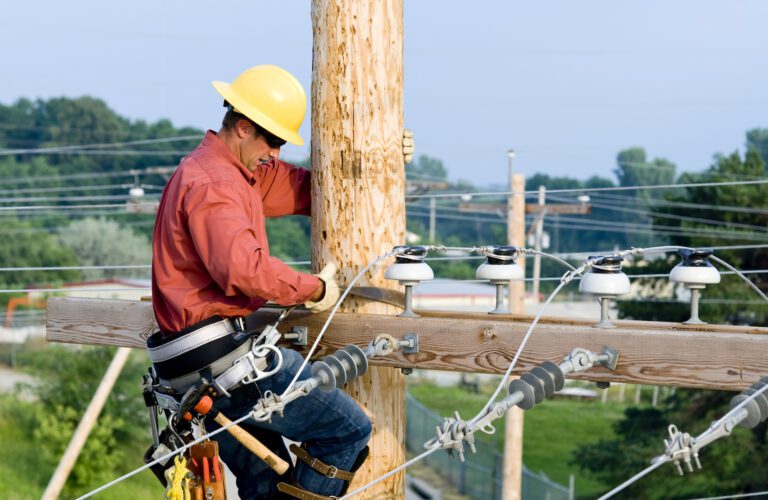Alternative Utility Pole Options
In this article, we’ll be looking at alternative utility pole options and giving an overview of their effects on safety, maintenance and overall environmental impact. We will also take a look at alternative readily available solutions used to increase the life of standard treated wooden power and telecom poles.
The following information is from a report published by AquAeTer, Inc regarding an environmental lifecycle assessment of wooden, steel, concrete and composite poles (Full report available on request). The products used in the report represent general product categories, which are subject to different designs and material contents. Three of the most commonly used alternatives to wooden poles are steel, steel-reinforced concrete and composite/plastic. The composite poles use a fibreglass construction, sometimes featuring an outer plastic coating. From an initial cost standpoint, all of the above options, as a general rule, incur a more significant initial purchase cost, with composite being particularly expensive due to its resource requirement for production.

Failure Modes and Lifespan
While we might assume that these more costly alternatives provide longer life, they are subject to many of the same issues of failure as wooden poles. Although traditional leaching and decay that we see in wooden poles are not present, both concrete and steel poles suffer from ground line corrosion this effect being made worse where poles are installed in acidic soil conditions. The lifespan of composite poles used in ground contact is currently an unknown with osmosis being a potential issue where conventional polyester resin systems are used. Osmosis significantly weakens composites over time. More costly epoxy resin systems offer much greater resistance to osmosis as do plastic encapsulated composites.
Anecdotal evidence indicates that concrete and steel poles typically have a service life of around 40 years. Use in acidic ground conditions combined with imperfections in the quality of galvanising can lead to failure of galvanised steel poles in a significantly shorter time period.
Impact on Installation and Maintenance?
Concrete poles are heavy and more challenging to handle than traditional wooden poles. The companies we work with who have used concrete poles tell us that the significantly greater weight of these poles brings new requirements in terms of transportation and lifting equipment plus new challenges in conducting a safe and efficient installation process. As a result, the cost of the pole and the installation cost increase significantly, also, it is worth noting that these poles cannot be easily climbed. The conductivity of steel reinforcement inside the pole is also a significant issue for many power distribution companies.

Environmental Impact
The use of alternative pole materials can also have a significant environmental impact, especially when it comes to CO2 emissions from pole manufacture. The majority of utilities have CO2 reduction targets as part of their commitment to corporate and social responsibility. The use of alternative pole materials can have a significant impact on meeting these targets. Whilst wooden poles typically capture and store around 320kg of CO2 from the atmosphere, the manufacturing of poles from alternative materials generates significant amounts of CO2.
For instance, for a typical utility that replaces 30 thousand poles a year, a switch from wooden poles to galvanised steel poles will see CO2 emissions increase by 33,000 tonnes a year. Whilst switching to concrete leads to an increase in emissions of 53,000 tonnes, the use of composites increases emissions by 35,000 tonnes a year*.
*Source “Conclusions and summary report of an environmental life cycle assessment of utility poles” Prepared by AquAeTer Inc.
Increasing Wood Utility Pole Life By +20 Years
In the first of this series of blogs we covered the causes of wooden pole failure and the methods of preventing this in detail. To summarise, wooden utility poles typically fail as a result of decay at the critical ground-line section of the pole due to the effectiveness of wood preservative diminishing over time due to oxidation and leaching. This leaves the pole vulnerable to decay, loss of strength and failure.
Decay starts at the mechanically highly stressed pole section in the upper 200mm (8″) of the ground where conditions are ideal for decay. This is because of high moisture content, oxygen and higher temperatures creating the perfect environment for decay to occur. Deeper in the ground and above ground, the conditions for decay are not generally present, and failure at these points is highly unlikely. The use of additional protection at the vulnerable ground line section of the pole provides a highly effective and proven means of overcoming the traditional weakness of wooden poles; ground line decay. In the next section, we will look at the options for achieving this.

Barrier Protection – Partial Barriers
Barrier products provide additional protection to a wooden pole at the vulnerable ground line section of the pole and work in conjunction with the wood preservative to increase pole service life. Barrier systems come in two types; partial and full barriers. Partial barriers are available in many forms such as a simple ground-line wrap, self-adhesive tape, heat shrink tube, wrap with a metal foil behind the outer wrap or a complete pull-on “bag” that covers the whole in-ground section of the pole. Partial barrier systems have one thing in common – they do not seal the surface of the pole behind the sleeve or bag. This means that preservative can be lost from the wood behind the barrier, and water can access the entire pole surface behind the outer barrier. Capilliary action between the outer sleeve and the wood “transports” moisture from the ground to the top of the sleeve. This creates a damp or wet band at the top of the bag or sleeve, allowing decay to occur at the top of the barrier or behind the barrier itself. Without entirely excluding moisture, oxygen, organisms and nutrients, there is still potential for decay to occur.

Total Barrier – Total Protection From Decay
Total barrier systems have a meltable sealant behind the outer barrier. The sleeve is heat applied causing the inner liner to melt and seal the pole surface, forming an air and watertight seal. This excludes all of the factors necessary for decay to occur, including oxygen and moisture. This seal ensures that the wood at the top of the sleeve remains below the 25% threshold at which decay can start whilst also preventing any loss of wood preservative from the protected zone. Total barrier sleeves such as Polesaver make conventional ground line decay impossible.


Total barrier sleeve showing air and watertight seal to the pole surface behind the outer barrier

Graph showing projected loss of pole bending moment strength over time for standard preservative-treated wooden pole and preservative treated pole protected with a Polesaver total barrier sleeve.
Summary
Alternative pole types of concrete, steel and composite may be advantageous in certain respects; however, wooden poles have shown to be more appealing from the viewpoint of cost, installation and environmental impact. Total barrier systems offer a proven and highly effective means of allowing wooden utility poles to match or better the life of alternative pole materials at a significantly lower cost. In the next blog, we will look in detail at partial and full barrier sleeves.
Learn More

+20 PROTECTION
Polesaver Sleeve
Polesaver protection sleeves prevent ground rot in wood utility poles and increase pole life by +20 years from the start, regardless of wood preservative type.

PRODUCT
Polesaver Sleeve
Polesaver ground-line barrier sleeves are a dual-layer, high-performance sleeve that prevents ground rot in wooden utility poles and gives an expected utility pole life of 50 years.
Or contact us today for further information









